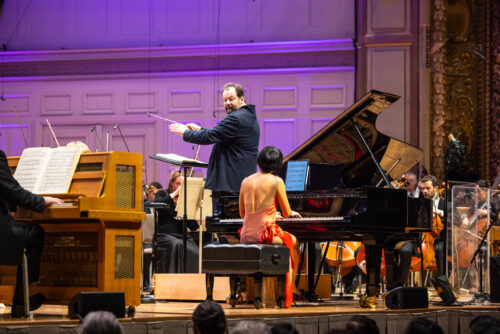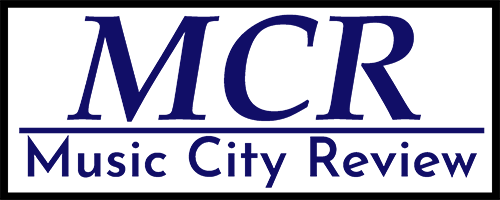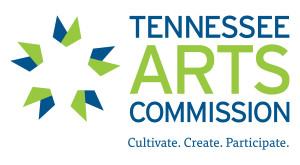Sobre ruedas y lonas:
Chauvet Arts’ Riding the Edge
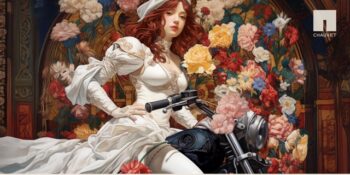
Version in English here
Del 30 de enero al 30 de marzo, Chauvet Arts, una galería de arte de Nashville, presenta una exposición titulada
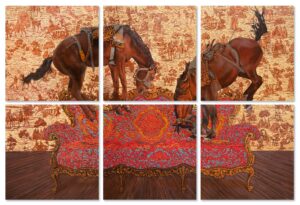
Riding the Edge: Passion, Arts, and Motorcycles. Cuando me enteré de esto por primera vez, pensé: “Oh, esto suena genial”. Una vez que entré por las puertas de su edificio, me di cuenta de que esta combinación va mucho más allá de lo que cualquier descripción podría esperar explicar. Esta muestra no es simplemente una mezcla de los dos mundos, sino una fusión del intrincado funcionamiento mecánico de las motocicletas y el talento diverso de los artistas contemporáneos. Y funciona muy bien.
Esta exposición, “primera en su tipo”, pone motocicletas icónicas con obras de arte de varios artistas, en varios medios. Ya sea que se trate del usual “____ en lienzo” o la fotografía que se muestra en la caja de luz LED, hay una gran diversidad de obras de arte para apreciar, creadas por artistas de distintas generaciones: si no recuerdo mal, el artista más joven presente tiene 22 años, y el mayor tiene 30+ años de experiencia en las artes. También hay varias motocicletas diferentes, que se remontan a 1916 (con la Columbia Bike).
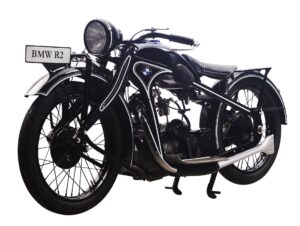
Keep Pets Off Furniture fue una de las pinturas más impactantes con las que me encontré. De Carlos Gámez de Francisco, este acrílico sobre lienzo representa a dos caballos saltando violentamente sobre un costoso sofá, con un fondo de imágenes más pequeñas que muestran la relación entre el ser humano y el caballo (animal/mascota) que se ha desarrollado a lo largo del tiempo. Esta relación ha sido un área de mucho interés para el artista, ya que siendo de Cuba y criado en un entorno donde los muebles eran muy apreciados, nunca debían ser algo para que las mascotas estuvieran cerca, un marcado contraste con la relación que las mascotas y sus dueños tienen en los EE. UU. Junto con el BMW R2 de 1931-36, un sello distintivo de su tiempo por su ingenio, diseño y asequibilidad, “Both highlight how possessions can transcend utility to reflect resilience and cultural significance.” – “Ambos destacan como las posesiones pueden trascender la utilidad para reflejar la resiliencia y la importancia cultural.”
Big City at Night encapsula la vida nocturna urbana con su vasto paisaje urbano, lleno de autopistas (y señales de tráfico), torres de agua y otros edificios industriales, y colores y automóviles. Contrastado por un fondo negro con toques de rojo, blanco y azul, y una mezcla de letras y símbolos dispersos, Daryl Thetford proporciona una sensación de caos a una escena conocida. Junto a este enorme collage (100 x 60 x 2 pulgadas, enmarcado) se encuentra la Moto Guzzi GTV de 1948. Con un máximo de 56 mph, esta bicicleta “evokes a sense of movement and energy” – “evoca una sensación de movimiento y energía” – con su característica pintura totalmente roja y cromado.
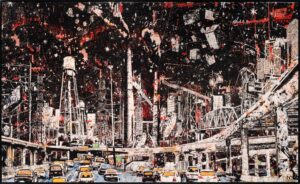
Durante mi visita, tuve la oportunidad de hablar con Madeline Cramer (¡cuyo nombre no supe hasta después de irme!), miembro del equipo de Chauvet Arts, jefe de Operaciones. Le hice algunas preguntas relacionadas con sus antecedentes, la historia de Chauvet Arts, así como la concepción de la exposición actual. Ubicado en Rep. John Lewis Way N, Chauvet Arts recibe una buena cantidad de negocios del centro de la ciudad; Al considerar esta exposición, el equipo de Chauvet Arts quería llamar la atención sobre el hecho de que las artes de Nashville tienen más que ofrecer que Broadway, por lo que tenía sentido colaborar con el Museo Lane Motors. Lane Motor Museum es el propio museo del automóvil de Nashville, que cuenta con una colección de alrededor de 150 (a la vez) coches históricos y únicos fabricados en varias partes del mundo. También hay algunas motocicletas prestadas por entusiastas de ellas. Tanto para los turistas como para los nativos de Nashville, Chauvet Arts quiere que todos sepan que están sucediendo cosas notables en TODAS partes en la escena artística de Nashville. Cramer también me contó sobre una visita reciente que una clase local de estudiantes de secundaria hizo a la galería: proporcionar este tipo de experiencias también es importante para el equipo de Chauvet Arts es posible seguir una carrera en la industria de las artes, pero también el poder de tener un espacio para crear y cómo eso puede afectarnos a nosotros mismos y a los demás.
También se exhiben muchas obras de arte diferentes que no están relacionadas con esta exposición. Ya sean las detalladas esculturas de madera talladas a mano de Brad Sells o la gran cantidad de fotografías enmarcadas, seguramente habrá algo para satisfacer los gustos de todos, y las billeteras, con algo para todos los presupuestos. Estaba especialmente feliz con su tienda de regalos, que está llena de arte, manualidades e incluso juegos de bricolaje a costos justos (¡volveré por ese juguete de cuerda!).
¡Asegúrate de ir a Chauvet Arts (y al Museo del Motor de Lane) antes de que termine esta exposición! Y una vez que termine, regresa, ¡porque mantienen vivo y auténtico el arte local (y regional)! Puedes estar seguro de que seguirán innovando, para brindar una experiencia única que todos disfruten y se conecten con el arte.
Preview:
2025 String Band Summit

Middle Tennessee State University’s Center for Popular Music will host the 2025 String Band Summit this Thursday through Saturday (2/27-3/1)
The annual String Band Summit gathers musicians, teachers, students, and scholars engaged in string band music to explore traditions, histories, practices, instruments, and pedagogy, seeking to foster collaboration and understanding both within and among different musical cultures, individuals, and institutions.
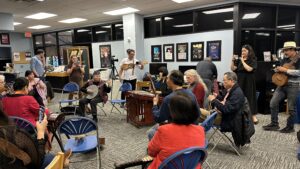
Old-time, son jarocho, cajun, bluegrass, and blues are some of the more common genres of string band music played solely with string instruments. These instruments include banjo, fiddle, guitar, mandolin, requinto, bass and many more. You can expect to hear groups of these instruments performing traditional songs as well as original compositions at the summit.
This will be the fourth annual summit and the second year it is held in Murfreesboro, Tennessee. The first two years it was hosted by the Eastern Tennessee State University’s Department of Appalachian Studies in Johnson City, Tennessee.
In 2023, the second year of the event, “crossing borders of genre and geography” was the theme of the summit and “contributions of African Americans to string band music” was the focus of performances, workshops, and presentations, highlighting the black experience in Appalachia.
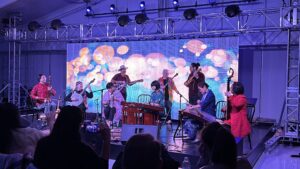
2024 featured a global scope combining the Center for Popular Music and Center for Chinese Music and Culture, both distinguished music research centers at MTSU. This summit explored the rich string band practices of East Asian cultures and featured performers such as the Han Ensemble, Uncle Shuffelo, and the Bryan Sutton Trio.
The 2025 event will seek to feature performance, teaching, and scholarship related to the rich string band musics of West Africa, including their profound connections to Caribbean and North American musical practices.
Dr. Greg Reish, Summit organizer and director of the Center for Popular Music states, “This year we are showcasing a number of musicians who represent rich fiddling traditions in Mexico, along with experts on Afro-Caribbean banjo history, the importance of string band music to community building and organization, and closer to home, the deep string band traditions of the Cumberland Plateau.”
Friday night’s free concert at Hinton Hall on MTSU’s campus will include Sotavento, Trenton “Tater” Caruthers, Paul Anastasia & Tina Pilione, and Trio Canto a Mi Terra.
I am very much looking forward to the music by Trio Canto a Mi Terra as well as the cylinder recording demonstration in the Bragg Media and Entertainment building which is home to the Center for Popular Music. Both the Center for Popular Music and the Center for Chinese Music and Culture are well worth the visit; I have always enjoyed their exhibits and events.
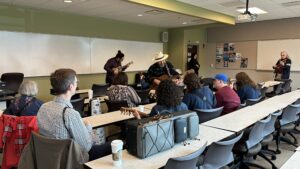
One of the most important missions of the String Band Summit is to gather younger scholars, students, and artists with the senior scholars and professionals of the field and allow them to interact closely and in a meaningful way reaching across genre boundaries. There is education through workshops and lectures, collaboration through the “jams” and creative sessions, and mentoring just by having experts available and accessible over a three-day period in a casual setting.
Historic Downtown Murfreesboro has been host to other relevant festivals for many years such as the Uncle Dave Macon Days held annually since 1979 to celebrate the legacy of the old time banjo player and first Grand Ole Opry star. My first time at Uncle Dave Macon Days was an unforgettable jam session on the porch of a cabin in Cannonsburgh Village with no less than 20 musicians from all over the country. That may be the sort of experience you can expect to find on the MTSU campus at the end of this week during the String Band Summit.
The 2025 String Band Summit is co-organized by Dr. Greg Reish and Dr. Lee Bidgood. The keynote presentation by Dr. Dena Ross Jennings is made possible with support from MTSU’s Distinguished Lecture Fund.
The full schedule and registration can be found here.
Un Concierto de Preguntas Sin Respuesta
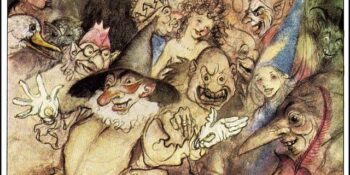
(English version here)
La lúgubre y húmeda noche del 11 de febrero, se aseguró de desterrar el espíritu deambulante del centro de la ciudad. Era tal la soledad que suscitaba sospecha. Como la abadía del príncipe Próspero, el
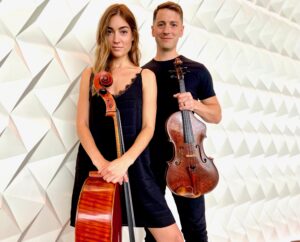
auditorio se protegía de la peste helada; uno a uno, cual encuentro clandestino, fue ocupando su sitio en el salón. Tres obras de naturaleza inortodoxa dieron sonido a los “Macabros Acertijos” que los asistentes aceptaron resolver. Tomando las palabras del violista Anthony Parce, en ocasiones la solución de estos acertijos no coincide con nuestras aspiraciones, más sin embargo al final contemplamos que encaja en el rompecabezas del destino.
Riddles, una composición fruto de la creatividad ontológica de Parce, se hizo tangible por primera vez en las manos de Grace Parce (cello), Rachel Miller (arpa) y de su autor. Con decisión, la obra se desata velozmente sobre una autopista de motivos alterados en las cuerdas mientras el arpa acaricia el agua emanando reflexiones lumínicas. Es incierta la hora del día y la procedencia abrupta del swing; tal vez el despreocupado ritmo del jazz es un alivio esporádico en medio de la rumiación. El cello introduce una melancólica línea que se adorna con vaporosos armónicos y pizzicatos en las cuerdas compañeras. Nuevamente la determinación procrastina y la emisora sintoniza un groove fresco con bases percutidas en la madera. La capota del auto se recoge y una cálida corriente de aire golpea en la cara. Un ¾ veraniego se aproxima con reminiscencias de alguna lengua romance en el que las frases gradualmente abandonan la casualidad y se transforman en sucinta pasión. Como un mantra el ostinato aferra a la mente al sosiego; el momento presente produce angustia, pero es la única realidad material. La viola se revela ante la imposición de ser un registro conciliador y se desahoga en un monólogo intenso y carnal. Entre miradas evasivas las tres almas se confiesan y la conversación concluye sin remordimientos.
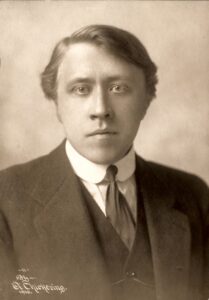
¿Habrán sentido remordimiento aquellos cortesanos que dejaron a la deriva a sus iguales para resguardarse en el fortín? André Caplet evoca en Conté Fantastique la infalible Máscara de la Muerte Roja de Edgar Allan Poe para reiterar que, aunque se pretenda burlar al tiempo, todo ciclo tiene su fin. El impresionismo no podía seguir evadiendo la crudeza del cambio de siglo; para encarnar esta transformación, el arpa fue una jugada maestra. El compositor aterriza el timbre de fábula de este instrumento a una narrativa asfixiante e indecorosa. Al trio sobre el escenario se unen las violinistas Sarah Page y Charissa Leung para marcar el inicio de la zozobra que se mantendría por los próximos 16 minutos. El cuento se desarrolla en escenarios simultáneos que abrazan el plano físico y emocional. El trazo inicial de la Máscara es desatendido por el festín que sucumbe únicamente a las once campanadas en el arpa. Tal vez suene obstinado que solo me refiera a este instrumento, pero para esta época las cuerdas frotadas ya nos han revelado un lenguaje técnico que el arpa no. Existe una versión alternativa para piano y cuarteto de cuerdas, por lo tanto, ya se pueden dar una idea de que las melodías no se someten esencialmente a contornos diatónicos y cromáticos, sino a bloques armónicos y rítmicos. Esta tendencia puede deberse a que Caplet dentro de su perfil integral como músico, haya incursionado también como percusionista.
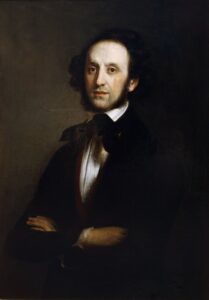
La complejidad en el diseño de la obra abstrae de tal manera la concentración de los intérpretes y de la audiencia, que no hay espacio para una ligera divagación mental. El aplauso al final era una mezcla de asombro y de alivio. El programa resarciría toda esta tensión con la lírica de Felix Mendelssohn, pero Anthony Parce de nuevo nos cuestiona acerca de la existencia. El Cuarteto para cuerdas en La menor, Op.13, generalmente se presenta como una pieza sobre el amor, pero Parce especifica que esta es una descripción superflua puesto que a partir de ese sentimiento se desprenden diferentes dilemas que no necesariamente están impregnados de melodías cantábiles. Para esta composición, Mendelssohn musicaliza algunos versos de su canción Frage (Pregunta). Desde el inicio, resuena la interpelación “¿Es verdad?”, que forma parte de una reflexión en la que el compositor anhela que su enamoramiento sea realmente correspondido. Detrás de este pensamiento, el cuarteto revela a un joven Mendelssohn con un marcado interés por el contrapunto imitativo y la fuga. Además, en aquella época coincidieron las publicaciones de los últimos cuartetos de Beethoven, ampliando así el panorama creativo del compositor. A pesar de que el diseño de la pieza se acoge al modelo del período clásico tardío, la construcción y el desarrollo de los temas son intensos y versátiles. Cada voz adquiere un carácter individual, favoreciendo que a través de melodías disjuntas, se aprecie la riqueza y amplitud de su rango.
Conforme la pieza iba avanzando pienso que sí permitió que nos liberáramos de la tensión previa y articuláramos de nuevo con nuestras emociones. Acostumbrada al histrionismo sudamericano, generalmente he percibido una actuación más pudorosa en el escenario sinfónico y camerístico de Nashville. En esta ocasión, siento que la combinación entre Caplet y Mendelssohn motivó a que los intérpretes exteriorizaran sin tapujo sus intenciones. Cabe decir también, que la habilidad de Mendelssohn para componer “canciones sin palabras” le agrega intensidad a la interpretación de las melodías. En el último movimiento esto es más que evidente cuando el violín introduce un recitativo impetuoso y apasionado que despierta la elocuencia de las demás voces. La obra finaliza en un tranquilo adagio con ideas vocales más extensas que nos devuelven nuevamente al juego de acertijos, ¿fue verdad?
A Performance of Unanswered Questions
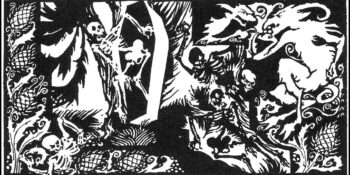
(versión en español aquí)
The bleak and damp night of February 11 made sure to banish the wandering spirit from Downtown. The solitude was so profound that it aroused suspicion. Like Prince Prospero’s abbey, the auditorium shielded

itself from the icy plague; one by one, as if in a clandestine gathering, each person took their place in the hall. Three unorthodox works gave sound to the macabre riddles the audience willingly set out to solve. Taking the words of violist Anthony Parce, at times the solution to these riddles does not align with our aspirations, yet in the end, we contemplate how it fits into the puzzle of fate.
Riddles, a composition born from Parce’s ontological creativity, became tangible for the first time in the hands of Grace Parce (cello), Rachel Miller (harp), and the composer himself. With determination, the piece unravels swiftly along a highway of altered motives in the strings, while the harp caresses the water, emanating luminous reflections. The hour of the day is uncertain, as is the abrupt emergence of swing; perhaps the carefree rhythm of jazz offers a fleeting relief amid deep contemplation. The cello introduces a melancholic line, adorned with airy harmonics and pizzicato from its fellow strings. Once again, determination procrastinates, and the broadcast tunes into a fresh groove, with percussive strokes on the wood. The convertible top is lowered, and a warm gust of air strikes the face. A summery ¾ rhythm approaches, reminiscent of a Romance language, where phrases gradually abandon randomness and transform into a succinct passion. Like a mantra, the ostinato anchors the mind to calmness; the present moment induces anxiety, yet it is the only material reality. The viola resists the imposition of being a conciliatory voice and unleashes itself in an intense, carnal monologue. Amid evasive glances, the three souls confess, and the conversation concludes without remorse.

Did those courtiers feel any remorse for abandoning their equals to their fate while seeking refuge in the fortress? André Caplet evokes the infallible Masque of the Red Death by Edgar Allan Poe in Conte Fantastique to reaffirm that, despite attempts to outwit time, every cycle comes to an end. Impressionism could no longer evade the harshness of the turn of the century; to embody this transformation, the harp was a masterful choice. The composer grounds the instrument’s fairytale-like timbre into a suffocating and indecorous narrative. The trio on stage is joined by violinists Sarah Page and Charissa Leung, marking the beginning of the unease that would persist for the next sixteen minutes. The story unfolds in simultaneous settings, embracing both the physical and emotional planes. The initial trace of the Masque is disregarded by the revelry, which only succumbs to the eleven chimes of the harp. It may sound stubborn that I emphasize this instrument, but by this time, the bowed strings had already revealed a technical language that the harp had not. There is an alternative version for piano and string quartet, so one can already imagine that the melodies do not strictly adhere to diatonic and chromatic contours but rather to harmonic and rhythmic blocks. This tendency might be attributed to Caplet’s comprehensive musical profile, which also included his experience as a percussionist.
The complexity of the work’s design demands such intense focus from both performers and the audience that there is no room for even the slightest mental wandering. The applause at the end was a mixture of astonishment and relief. The program would ease all this tension with the lyricism of Felix Mendelssohn, yet once again, Anthony Parce challenged us with existential questions.

The String Quartet in A minor, Op. 13 is generally presented as a piece about love, but Parce specifies that this is a superficial description, as this sentiment gives rise to various dilemmas that are not necessarily imbued with cantabile melodies. For this composition, Mendelssohn set some verses from his song Frage (Question) to music. From the very beginning, the interrogation “Is it true?” resonates, forming part of a reflection in which the composer longs for his love to be genuinely reciprocated. Beneath this thought, the quartet reveals a young Mendelssohn with a pronounced interest in imitative counterpoint and fugue. Moreover, at that time, the publication of Beethoven’s late quartets coincided, further expanding the composer’s creative horizon. Although the piece’s design follows the model of the late Classical period, its construction and thematic development are intense and versatile. Each voice acquires an individual character, allowing the richness and breadth of its range to be appreciated through disjunct melodies.
As the piece progressed, I believe it did allow us to release the previous tension and reconnect with our emotions. Accustomed to South American histrionics, I have generally perceived a more restrained performance style in Nashville’s symphonic and chamber music scene. On this occasion, however, I felt that the combination of Caplet and Mendelssohn encouraged the performers to express their intentions without modesty. It is also worth mentioning that Mendelssohn’s ability to compose “songs without words” adds intensity to the performance of the melodies. This becomes most evident in the final movement, when the violin introduces an impetuous and passionate recitative that awakens the eloquence of the other voices. The piece concludes with a tranquil adagio, featuring longer vocal-like phrases that return us once more to the game of riddles—was it true?
Touring Middle Tennessee:
When Marian Sang

Throughout the months of February and March, Nashville Opera’s production of “When Marian Sang: A Celebration of the Life of Marian Anderson” is touring throughout the Middle Tennessee area. This 40-minute showcase focuses on the life of Marian Anderson, a contralto who became the first black opera singer to perform at the Metropolitan Opera in a principal role.
The format of the show is based on a children’s picture book by Pam Muñoz Ryan of the same name. The performance alternated between a narrator, Yolanda Treece, reading passages from the book and soprano, Tamika Grier, singing excerpts of spirituals, the famous “My Country ‘Tis of Thee”, and a showstopping aria that brought the house down. Stephen Carey, Nashville Opera’s Chorusmaster and Engagement Director, also beautifully accompanied the performance on the piano.
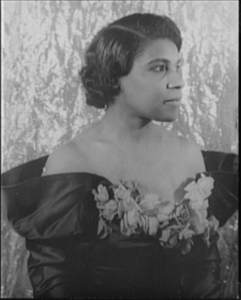
The timeline of the program followed Marian’s life from when she was a “baby contralto at 10” to when she ultimately achieved her dream of singing at the Metropolitan Opera House. The book detailed her life growing up singing in a Baptist church, her dreams of going to music school, her work with voice teacher Giuseppi Boghetti, and overcoming discrimination and prejudice in society. The whole program was very interesting, and Grier’s powerful, rich lower register paired with her sparkling high notes resonated throughout the music hall. Treece’s warm, inviting narration also harbored a very intimate space where important, uncomfortable parts of history were able to be discussed.
As each segment of narration ended, Grier sang many spirituals to represent Marian’s religious upbringing and her life as a black woman before and during the Civil Rights Movement. These pieces included “Go Down Moses,” “Deep River,” and “Sometimes I Feel Like a Motherless Child.” This created a very somber and reverent atmosphere as the program detailed Anderson’s struggles and obstacles performing as a woman of color. Grier’s rendition of “My Country ‘Tis of Thee” was stunning and aimed at replicating the historic moment of Anderson performing this on the steps of the Lincoln Memorial. As the book came to an end, Grier abandoned her music stand and performed “O Mio Babbino Caro” from Gianni Schicchi by Puccini. This was the musical and vocal highlight of the performance giving audience members goosebumps. However, it left me wanting a little more.
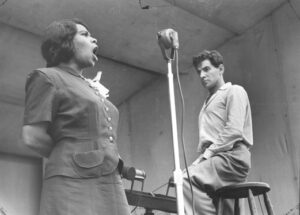
My biggest qualm with this production was that Marian Anderson famously was a contralto, while Tamika Grier has a singing career as a soprano. Casting a soprano in this showcase created a divide between what the audience was hearing and the actuality of Marian Anderson’s voice. I also wish that the final piece had been from the actual role she premiered in, which was Ulrica in Verdi’s Un Ballo in Maschera. To me, the choice of “O Mio Babbino Caro” felt random and overdone. While Grier beautifully sang the soprano aria, there was a disconnect with the end of the performance.
However, despite this it was a great showcase of music and opened many people’s eyes to the life of such an influential opera singer. I love the fact that Nashville Opera creates showcases like this and takes it all throughout the Nashville area. It is a wonderful chance for the community to hear beautiful music and learn about important musical history free of charge. I highly recommend attending the performance if for nothing else to learn about Marian Anderson’s life and how she overcame racial discrimination and prejudice in a world that seemed against her. She never let her love for music waver, and her legacy will continue to live on creating a safe space for important progress to occur.
at TPAC
&Juliet is as Merry as the Day is Long
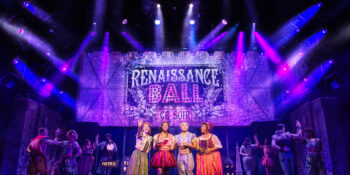
February 11th was the opening night of &Juliet at Tennessee Performing Arts Center. This jukebox musical is a re-imagining of Romeo and Juliet by William Shakespeare written by David West Read and featuring music by Max Martin. His name might be unfamiliar, but the pop songs certainly aren’t. Just to name a few: “Oops I Did it Again,” “It’s My Life,” “Everybody (Backstreet’s Back),” and “Roar.” A meta-narrative, the musical begins with Anne (Teal Wicks), Shakespeare’s wife, coming to the opening night of Romeo and Juliet. When she hears what he has planned for the ending, she insists that she can write a better one. When he agrees to this, they work together, often bickering, to create a whole new play just about Juliet (Rachel Simone Webb) who doesn’t kill herself after Romeo does and finds out at his funeral that he’s been dating lots of other people. Her parents want to send her to a nunnery (I was so ready for a joke here as the term nunnery was used as slang for “brothel” in the 1600’s, but none came). Juliet runs away from home and goes clubbing in Paris with her friends, quickly becoming entangled in another engagement. Along for the journey is her best friend May (Nick Drake), her friend April (a character that Anne creates so that she can go into the play), and her nurse, Angélique (Kathryn Allison). Unlike Romeo and Juliet, this play is a comedy with a happy ending for all.
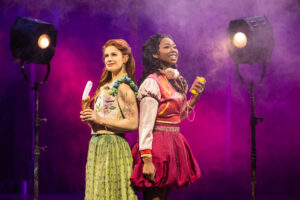
Webb is a stunning Juliet with a beautifully powerful voice. She manages to make you feel as if you’re Juliet’s friend as well, coming along to dance, laugh, and offer a shoulder to cry on. Despite the play being named for her, a great deal of the play is really about Anne, who is striving to find her own way and her own happiness. We know only a little of Shakespeare and Anne’s marriage: they were estranged for the majority of their marriage and Shakespeare’s lengthy will included only one sentence for Anne: “I give unto my wife my second best bed with the furniture.” David West Read gives her a voice, and brings her to life. Wicks is charming as Anne with impeccable comic timing. It’s impossible not to empathize with her and side with her. And yet, you don’t dislike Shakespeare (Corey Mach) who helps bring the lovers of the story together and adds needed conflict. Mach is able to balance Shakespeare’s arrogance with his charisma, making him undeniably likable. Another stand out performance is by Nick Drake as Juliet’s friend non-binary friend, May.
May brings us the most touching parts of the play as they explore their identity and what that means for their personal and romantic life. Although Juliet has agreed to marry Franҫois (Mateus Leite Cardoso) to satistfy their parents, there is no romance between them. May, who bumped into Franҫois earlier is falling in love him and trying to keep it inside. The big kiss between May and Franҫois is one of the sweetest moments. Drake perfectly embodies the fun, vivacious nature of May while also being soft and tender as they find someone to love. Cardoso played a sweet, shy Franҫois. One thing I didn’t care for was the sing-song, high pitched quality to his voice. I think it was done in an attempt to make his character seem anxious and perhaps a bit silly, but it was distracting and I much preferred his voice when he was singing. There was also a very cute romance between Angélique and her old flame, Lance (Paul-Jordan Jansen), Franҫois’s father. Kathryn Allison as Angélique was, by far, the sexiest character, fully aware of herself and what she deserved without youthful naivete. It was very nice to see a romance between characters that weren’t young kids exploring their first relationships.
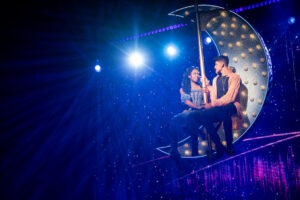
Lance is French and Jansen played him with a silly accent that was funny but at times frustrating. Allison sounded so amazing in her rendition of “Teenage Dream” (truly, I’d rather hear her sing it than Katy Perry) and I was annoyed that Jansen was singing along with his exaggerated accent, basically ruining it. My favorite moment of the play is at the very end of Act I when Shakespeare decides to bring Romeo (Michael Canu) back to life. Shakespeare gestures and smoke comes up, the lights shine, and Romeo descends from the ceiling singing “It’s My Life.” Canu was the best himbo with his dumb, frat boy vibes and a rockstar quality that can’t be denied. The character is a little one note, but Canu plays it perfectly providing lots of laughs.
The costuming by Paloma Young is absolutely inspired, blending Elizabethan era corsets and doublets with short skirts and crop tops. Its fresh and new with bright jewel tones. The set design by Soutra Gilmour is flashy and fun. The sound mixing was exemplary, the music and voices were perfectly balanced. Ever character was well cast, and I especially loved the diversity of race and body type in the actors.
Bright, fun, and high energy, &Juliet is full of great pop anthems and witty banter. However, if you’re looking for anything deeper that that, you’ll be disappointed. If one is going to write a play suggesting Shakespeare needs some updating, I would assume that the new play would have some message or leave me with a feeling other than “well, that was cute.” And yet, Read did a good job honoring Shakespeare while gently poking fun at him. Not every play needs to be profound. Sometimes it’s fun to just turn off your brain and dance to Britney Spears. To use a phrase coined by Shakespeare, &Juliet is “as merry as the day is long.”
Pride and Prejudice
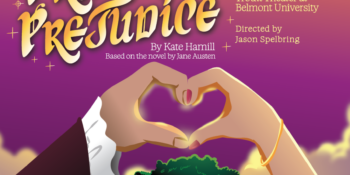
Following the series of creative adaptations of classical literature comes Pride and Prejudice, a retelling of Jane Austen’s novel.
Described as “not your grandmother’s Austen”, the collaboration between Belmont University’s Department of Theater and the Nashville Shakespeare Festival features a similar narrative to the classic with a modern twist. Similar to Austen’s Elizabeth, Lizzy Bennet is determined not to be married. But when Mr. Darcy begins popping up at every turn, Lizzy finds it increasingly difficult to resist the man’s charm.
Be sure to tune into Lizzy Bennet and Mr. Darcy’s “will They, won’t they” at Belmont University’s Troutt Theater beginning February 20th. For more information, visit the Nashville Shakespeare Festival.
The MCR Interview:
Cellist Inbal Segev on Bach, Adamo and Her Compositional Process
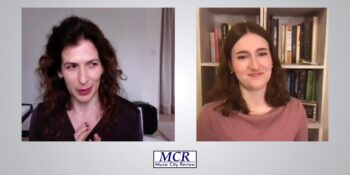
Music City Review Journalist Jayna Powell speaks with Cellist Inbal Segev about her career, her working relationships with composers like Mark Adamo, Anne Clyne and Timo Andres, as well as her own approach to the practice of composition. They discuss their favorite halls, airlines and Bach preludes as well as the coming concert with the Nashville Symphony where Segev will perform Mark Adamo’s Last Year for the first time.
Mental Health: Healing Blues.

On Sunday, January 26th, I had the opportunity to attend the Mental Health: Healing Blues and Jazz event hosted by the Tennessee-Western Kentucky Conference of the United Methodist Church at the Scarritt-Bennett Center. The Scarritt-Bennett Center was a beautiful venue to host the event with its historical and charming architecture and environment. This program aimed to bring awareness to mental health issues through music, specifically jazz and blues. Upon entering the building, they had service tables in front of the mental health event room, offering professional services to those who would like more support. The event was perfect for an afternoon of blues and jazz music. It was warm and cozy and they had food and drinks for the audience to sit back and enjoy the music.

At the event’s start, Crystal Joy was the MC of the afternoon, and she introduced all the artists, including musicians and visual artists. Henry Jones is a spoken word artist who performed with Henry Perry, a harmonica blues musician. The latter session included a performance by jazz vocalist Connye Florance and pianist Kevin Madill. Visual artist and MTSU alumnus Reverend Linda Furtado painted a thought-provoking piece with many vibrant colors throughout the musical performances as well.
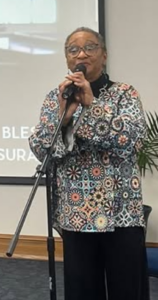
The first piece performed was titled “Do Not Lose Your Mind Today,” written and spoken by Henry Jones. Henry Perry performed on harmonica during this piece, adding to the poem’s effects. This piece was quite fun to listen to, with Jones’s deep narrative voice and the added harmonica effects from Mr. Perry. It was a beautiful story of how the mind can spiral into trouble and darkness. The twang of the harmonica creates an almost wild west aesthetic that builds on the intensity of the mind’s troubled thoughts. Perry does a fantastic job of creating tension in the story through this improvisation. It is an excellent piece to describe the current stigma on mental health issues. The negative stigma of how those with mental health issues are unable to overcome their illness. He drew upon this point in his song by acknowledging that this perception must be destigmatized because it is simply not true and that people who suffer from mental issues should not give up.
They performed another piece that featured more of the harmonica. It starts off with Henry Jones narrating the poem describing a metaphorical representation of a person acting as a child throwing a tantrum. Henry Perry then joins in and portrays this child-like tantrum with his harmonica by accelerating through quick staccato notes, denoting a rise of tension of an energetic child dancing around. He does a great job utilizing different techniques. For instance, he would vibrato and slide on the instrument, creating a quick glissando between a controlled number of notes. It was fascinating to hear this be performed live. The long vibratos that Perry communicates demonstrate this longing for peace. The ending also portrays this eventual destination of peace, to which Henry Jones stated, “I am free.” The ending encourages those with troubled souls to seek freedom through God’s gentle grace. Perry ends this piece with another harmonica moment, drawing upon the fun nature and twang of the instrument. Everyone chuckled at his funny outro of the piece.
The following piece is titled “If You Just Smile,” sung by Connye Florance with piano accompaniment by Kevin Madill. Connye beautifully glides her voice across this piece, bringing a soulful texture similar to Ella Fitzgerald. Her dream-like voice transported the audience into a comforting session that made them forget about life’s troubles. Madill’s playing also reinforced her voice, adding to this aesthetic through his superb, delicate playing. Their performance lit up the whole room, spreading many smiles across the audience. They also performed another piece titled “Now Is the Time.” Florance sings a lovely melody, encouraging those with mental health issues to choose today as the time to get help where it is needed. It was very soulful and cheerful, creating a welcoming atmosphere for those looking for healing.
After the event, I checked out some of the tabled services there. Vanderbilt’s Alzeheimer Research Center, healthcare for the elderly, and career coaches from Goodwill were all there and offered great advice and forms for anyone that needed it.
It was a comforting event, with much light and fruit and people willing to work through and help. I thoroughly enjoyed this jazz and blues session hosted by the Tennessee-Western Kentucky Conference of the United Methodist Church. It was a very exceptional performance by these professional musicians, and I hope to listen to them again.
“Overflowing and Unlimited . . .” – Nelsons and the BSO release live recording of the Turangalîla-Symphonie
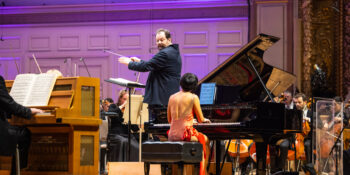
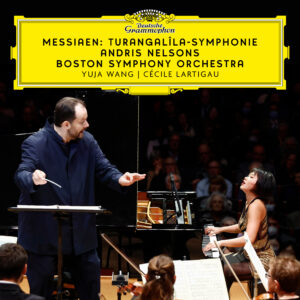 I will admit that I have a rather large soft spot for the music of Olivier Messiaen. Experiments with total serialism, Medieval and Hindustani rhythmic influences, incorporation of bird song (if somewhat freely adapted), modes of limited transposition, nods to Japanese Gagaku and Balinese gamelan, all imbued with a religious mysticism through the lens of synesthesia and a truly original approach to orchestration – what’s not to love? So, when I discovered that the Boston Symphony Orchestra and Deutsche Grammophon would be releasing a live concert recording of Messiaen’s Turangalîla-Symphonie to coincide with the 75th anniversary of the work’s word premiere, my inner music nerd was thrilled that the work was being recognized in this way.
I will admit that I have a rather large soft spot for the music of Olivier Messiaen. Experiments with total serialism, Medieval and Hindustani rhythmic influences, incorporation of bird song (if somewhat freely adapted), modes of limited transposition, nods to Japanese Gagaku and Balinese gamelan, all imbued with a religious mysticism through the lens of synesthesia and a truly original approach to orchestration – what’s not to love? So, when I discovered that the Boston Symphony Orchestra and Deutsche Grammophon would be releasing a live concert recording of Messiaen’s Turangalîla-Symphonie to coincide with the 75th anniversary of the work’s word premiere, my inner music nerd was thrilled that the work was being recognized in this way.
Messiaen never really does anything halfway, and the Turangalîla-Symphonie as a “hymn to joy” is no exception. Serge Koussevitzy and the Boston Symphony placed no limitations when commissioning the work in 1946, but one doubts that a ten movement work for large orchestra, featuring extensive percussion colors, the electronic ondes Martenot, and a virtuoso piano part was what they anticipated. Perhaps due to these features and not in spite of them, Turangalîla-Symphonie has become one of Messiaen’s most iconic works. With pianist Yuja Wang and Cécile Lartigau’s ondes Martenot, the BSO revisited this commissioned work last April and have released the live recording created from these concerts.
Andris Nelsons and the BSO hold nothing back in this often muscular interpretation. After all, Messiaen can be direct at times, and often lets his stronger structures bluntly speak for themselves. Nelsons certainly didn’t shy away from Messiaen’s extremes – allowing the dense and powerful gestures to come to the fore, at times with a surgical clarity and transparency. Though perhaps due to the limitations of dynamic nuance available on recordings, the contrast between the sweeping full ensemble statements and the intimate but lush responses was not as effective as I have experienced in live performances of the work. The statue theme, love theme, and glissandi in the ondes Martenot were often allowed to grow to their fullest expression – likely very effective in a live performance within a large concert hall where the sound has room to dissipate, but at points on the recording they could be so omnipresent that they were more reminiscent of a Tex Avery production than Messiaen’s orchestral expression of all encompassing love.
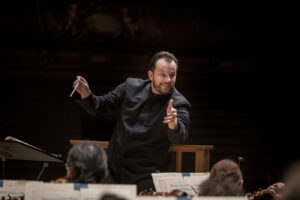
As this was a recording of a live concert performed for an audience rather than a production solely for studio microphones, some balance issues or imprecision might be expected. And though there were a few balance issues and sometimes a lack of dynamic contrast (again expected in recorded formats), the musicians of the BSO are polished and flawless in their execution. Issues with balance and dynamic range tend to work against any composition, but for a composer who communicates so effectively via coloristic contrast and textural variation, it can be difficult for the dynamic range of a recording to fully convey these exchanges with the nuance that makes this work so iconic.
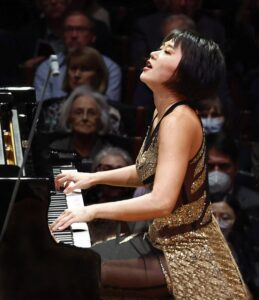
However, no lack of dynamic subtlety stood in the way of Nelsons’s willingness to embrace the extremes of Messiaen’s tutti writing – offering listeners the opportunity to lose themselves within the meticulous complexity of Turangalîla’s most robust moments. Of particular note, the frenetic energy and multiple layers of the fifth and tenth movements were delivered with impressive machine-like precision. Spurred by Nelsons’s bright tempo, the orchestra shimmered through the density of Messiaen’s climactic final movement with a spirit of excitement that must have been thrilling live and is certainly captured on the recording. Still, the timbral juxtapositions enjoyed in live performance can be a little flat in the recorded format (especially in busier textures), amounting to a kind of constant sensory overload of discrete statements rather than a complementary cascade of orchestral colors. Of course, in these larger contexts, being overwhelmed by Messiaen’s orchestration is kind of the point – but one wishes to be forcefully transported by the majesty of a cohesive if multi-faceted whole rather than dazzled piecemeal by the sum of its parts. Perhaps in these instances the limitations of the live recorded format cannot fully translate Nelsons’s interpretation.
Though the shared intimacy of live acoustic performance is difficult to duplicate, the recording is not without its sublime moments. The crystalline delicacy of the sixth movement Jardin du sommeil d’amour (Garden of love’s sleep), is an exercise in the power of understatement. Cécile Lartigau’s ondes Martenot blends perfectly with the muted string theme, providing a languid environment for the delicate interplay of flute, clarinet, piano, and percussion. Likewise, the solo piano work and delicate woodwinds preceding the statue theme at the conclusion of Chant d’amour 2, and the coloristic exchanges in the softer sections of the third movement, Turangalîla 1., were masterfully executed.
Yuja Wang’s performance throughout displays a strong understanding of the piano’s role within the context of the work – adding the important soloistic interjections when needed without overshadowing the ensemble. The solo piano part isn’t quite a concerto (even though the demands of the part may suggest otherwise), and this important color is required to both blend and stand out as a soloist. In the work’s more soloistic passages, Yuja Wang did not disappoint. Her playing is assured and agile, dancing through Messiaen’s angular material with grace and ease.
As a representation of the BSO’s live performance, the recording is a testament to an energetic interpretation with no lack of enthusiasm for Messiaen’s embrace of excess. Studio recordings such as Esa-Pekka Salonen’s 1986 release with the Philharmonia Orchestra or the initial recording by Seiji Ozawa and the Toronto Symphony released in 1968 may offer more nuanced readings of the work. Even so, the BSO’s committed and passionate offering catalogs a live performance that lives up to Messiaen’s own description of the work in the liner notes of the (definitive according to Messiaen) 1990 Myung-Whun Chung recording with the Orchestre de l’Opera Bastille as “a joy that is superhuman, overflowing, blinding, unlimited.”
Though the recording may feel heavy at times, the clarity of the musicianship is evident throughout. Nelsons’s performance is aggressive and leans into the extreme aspects of the work, as one might expect with such epic music. I’m thankful that the BSO chose to highlight and record such an important work. The live recording captures the exuberance and directness of the BSO’s performance and should inspire listeners to seek out more opportunities to engage with live performances of contemporary masterpieces.
